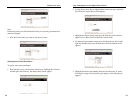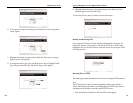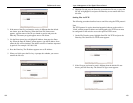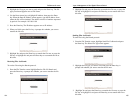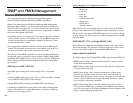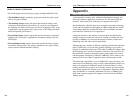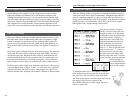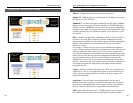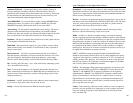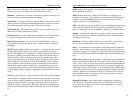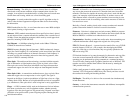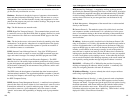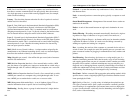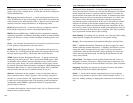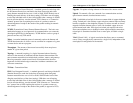
Broadband - A data-transmission scheme in which multiple signals share the
bandwidth of a medium. This allows the transmission of voice, data and video
signals over a single medium. Cable television uses broadband techniques to
deliver dozens of channels over one cable.
Browser - A browser is an application program that provides a way to look at
and interact with all the information on the World Wide Web or PC. The word
"browser" seems to have originated prior to the Web as a generic term for
user interfaces that let you browse text files online.
BSS (Basic Service Set) - An infrastructure network connecting wireless
devices to a wired network using a single access point.
Buffer - A buffer is a shared or assigned memory area used by hardware
devices or program processes that operate at different speeds or with different
sets of priorities. The buffer allows each device or process to operate without
being held up by the other. In order for a buffer to be effective, the size of the
buffer and the algorithms for moving data into and out of the buffer need to
be considered by the buffer designer. Like a cache, a buffer is a "midpoint
holding place" but exists not so much to accelerate the speed of an activity as
to support the coordination of separate activities.
CAT 5 - ANSI/EIA (American National Standards Institute/Electronic
Industries Association) Standard 568 is one of several standards that specify
"categories" (the singular is commonly referred to as "CAT") of twisted pair
cabling systems (wires, junctions, and connectors) in terms of the data rates
that they can sustain. CAT 5 cable has a maximum throughput of 100 Mbps
and is usually utilized for 100BaseTX networks.
CAT 5e - The additional cabling performance parameters of return loss and
far-end crosstalk (FEXT) specified for 1000BASE-T and not specified for
10BASE-T and 100BASE-TX are related to differences in the signaling
implementation. 10BASE-T and 100BASE-TX signaling is unidirectional-
signals are transmitted in one direction on a single wire pair. In contrast,
Gigabit Ethernet is bi-directional-signals are transmitted simultaneously in
both directions on the same wire pair; that is, both the transmit and receive
pair occupy the same wire pair.
Cookie - Data created by a Web server that is stored on a user's computer. It
provides a way for the Web site to keep track of a user's patterns and prefer-
ences and, with the cooperation of the Web browser, to store them on the
user's own hard disk.
115
Layer 2 Management 4-Port Gigabit Ethernet Switch
ProConnect II
®
Series
Automatic Fall-back - A feature provided by some wireless products to
increase connection reliability. Automatic fall-back enables a device to
dynamically shift between various data transfer rates. It works by decreasing
the data transfer rate when interference increases, distance increases, and
other factors undermine signal strength and quality.
Auto-MDI/MDIX - On a network hub or switch, an auto-MDI/MDIX port
automatically senses if it needs to act as a MDI or MDIX port. The auto-
MDI/MDIX capability eliminates the need for crossover cables.
Auto-Sensing - To automatically determine the correct settings. The term is
often used with communications and networking. For example, Ethernet
10/100 cards, hubs and switches can determine the highest speed of the node
they are connected to and adjust their transmission rate accordingly.
Backbone - The part of a network that connects most of the systems and net-
works together and handles the most data.
Bandwidth - The transmission capacity of a given facility, in terms of how
much data the facility can transmit in a fixed amount of time; expressed in
bits per second (bps).
Beacon Interval - A beacon is a packet broadcast by the Access Point to
keep the network synchronized. A beacon includes the wireless LAN service
area, the AP address, the Broadcast destination addresses, a time stamp,
Delivery Traffic Indicator Maps, and the Traffic Indicator Message (TIM).
Bit - A binary digit. The value - 0 or 1-used in the binary numbering system.
Also, the smallest form of data.
Boot - To cause the computer to start executing instructions. Personal com-
puters contain built-in instructions in a ROM chip that are automatically exe-
cuted on startup. These instructions search for the operating system, load it
and pass control to it.
Bottleneck - A traffic slowdown that results when too many network nodes
try to access a single node, often a server node, at once.
Bridge - A device that interconnects different networks together.
114



